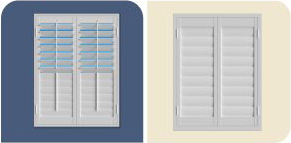
Plantation Shutter Myths Debunked
We’ve dismantled some shutter myths in the past. During our previous myth-busting spree, we looked at a few common misunderstandings people have regarding interior shutters in Hartford.
This time, the Sunburst Shutters Connecticut team is back to set the record straight on a few more myths we’ve been hearing from shutter-buyers around CT. Let’s take a look.
Myth #1: “Plantation Shutters Are Meant For Southern Houses.”
When some homeowners hear the phrase “plantation shutters,” their minds typically conjure the image of a giant, sprawling southern house surrounded by plains. Although it’s true that the shutters owe their name to that location and time, plantation shutters in fact had huge popularity much earlier and much later than 19th Century Southern America.

Nevertheless, plantation shutters offer those exact same benefits to any style of home. Craftsman style houses can utilize shutters, just as Colonial homes, Prairie houses, and even beach houses can.
Myth: “My House Style Won’t Work With Shutters Is Too Distinct For Shutters.”
Because plantation shutters saw so much use over time, some people might think that shutters may seem somewhat boring. We’ve heard a customer say before that their home was “too distinct” to install shutters, which was a tad confusing–since shutters are likely the one and only window treatment that can accentuate any style.

Myth: “Shutters And Blinds Are Just About The Same Thing.”
For some reason, there happens to be a lot of confusion over the difference between blinds and shutters. Perhaps it has to do with homeowners conflating “slats” and “louvers,” or it’s the similarity in shape that causes the confusion. No matter the reason, blinds and shutters are pretty easy to distinguish when you look at their features. Below is a basic breakdown of both.
| What’s the difference? | Blinds | Shutters |
| Can they block out the entire window? | No | Yes |
| Structure | Suspended from cord | Solid frame attached to window frame |
| How long will they last? | Can wear down or deteriorate after 2-3 years. | Can usually last 20+ years. |
| Permanent or temporary? | Temporary | Permanent |
| Can they increase home value? | No | Yes |
| Energy Efficiency | Minimal | Can block up to 30 degrees of outside temperature. |
| Specialty Windows | No | Yes. |
| What are the horizontal parts called? | Slats | Louvers |
Myth: “All window coverings offer basically the same energy efficiency.”
As the “Blinds vs. Shutters” table above mentions, window coverings can vary by a wide margin on how much energy efficiency they offer. The structure, material, and construction can all play a huge part in how much energy efficiency a window treatment offers.
At the bottom rung of energy efficiency is leaving your window completely bare. Offering only a tiny bit more energy efficiency are your everyday retail mini blinds. More energy efficient than those are draperies and sturdy fabric window coverings. Getting into somewhat noticeable territory we have most wood shutters and cellular shades, made to offer UV protection and heat reduction. But at the very top of the mountain are Polywood plantation shutters, constructed to both reflect and block outside temperature from passing into your home.
No More Shutter Myths
If you feel like you’re swimming in an ocean of misinformation when it comes to window treatments, we can throw you a lifeline. Call Sunburst Shutters Connecticut today at 860-266-5459 to talk to one of our experts and set up a complimentary in-home consultation to find your perfect shutter or window treatment today.


